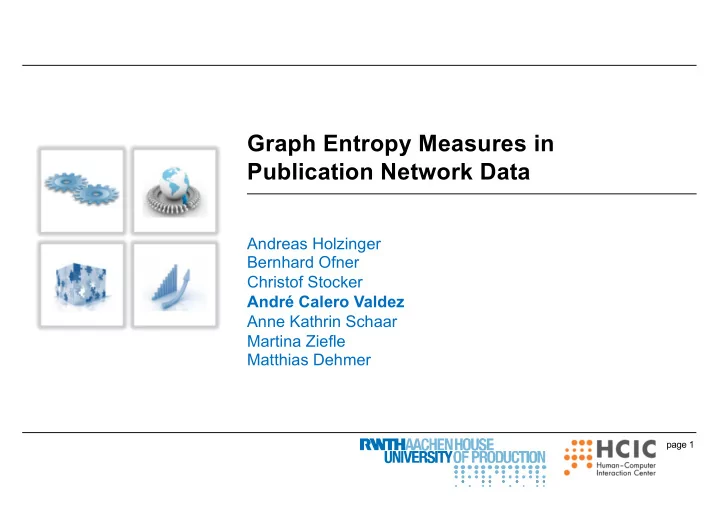

Graph Entropy Measures in Publication Network Data Andreas Holzinger Bernhard Ofner Christof Stocker André Calero Valdez Anne Kathrin Schaar Martina Ziefle Matthias Dehmer page 1
Agenda 1 Overview CSP1 - Interdisciplinary Innovation Management 2 Publication Network Visualization 3 Cluster-App Vision page 2
Research Background page 3
Disciplinary backgrounds and methodologies of the CSP1 page 4
Research Questions n How can one measure scientific success in interdisciplinary teams? n Which means can support interdisciplinary cooperation ? n And how does the cybernetic approach apply for management of interdisciplinary success? page 5
CSP1-fields of action and research questions Knowledge & Cooperation Engineering Interdisciplinary Innovation Management Diversity Management Performance Measurement page 6
Agenda 1 Overview CSP1 – Interdisciplinary Innovation Management 2 Publication Network Visualization 3 Cluster-App Vision page 7
What is scientific success? n The DFG has issued criteria for research clusters: – Blind Peer Reviewed Publication § Impact Factor – Completed Dissertations – Acquired third party funding n We focus on publications – Publically available information – Reflect scientific cooperation – Reveal interdisciplinarity n How can we find interdisciplinarity in publication data at the micro level? page 8
Publication Network Visualization n Network Graph (Nodes and Edges) n 2 Type of Nodes – Author (A) – Publication (P) n 1 Type of Edge for a Relationship – isAuthorOf (connects A and P) n Force Atlas Layout – Two nodes attract each other, if they are connected by an edge. – Two nodes repel each other, if they are not connected by an edge. => Visual grouping of nodes according to „relationship-nearness“ page 9
Cluster publication vizualisation n How can we interpret this graph? n Measures of centrality – Grayness codes for degree centrality – Node Size codes for betweeness centrality n Centrality gives node based information n What about subgraphs and total graph properties? n Graph-Entropy measures the amount of information coded by a graph page 10
What is Graph Entropy? n Entropy amount of uncertainty – Empty graphs and complete graphs have low entropy n Various interpretations exist – Shannon Entropy can not be uniquely mapped n 2 major variants exist – Invariant based Entropy measures § Partition according to an invariant (e.g. degree) § Measure probability of vertex being in invariant-class – Information functionals (f) § Every vertex is assigned a real number (according to the functional): f(v i ) § From the sum of those number a probability is derived p f (v i ) § => Entropy (benefit: calculable in polynomial time) page 11
Evaluation of the Cluster Network n Different results for different entropies n I mowsh is based on graph automorphism – measures symmetry – Max I(G)=9.6366 (=log 2 (|V|) – Graph is very unsymmetrical (globally) n I dehm is based on vertex neighborhood diversity – Measures asymmetry – Max I(G)=9.6366 – Graph is very symmetrical (locally) page 12
Interdisciplinary Innovation Management n Research approach for the CSP1 n Idea from cognitive psychology/computer science – The quantified self – Self-measurement as a self-management tool n Measuring and visualizing success factors leads to a better and awarer handling of these factors. – Allows identification of critical factors – Derivation of cluster specific interventions § Trainings, Seminars, etc. – Measurement of intervention success. page 13
Agenda 1 Overview CSP1 2 Cluster Terminology (Glossary) 3 Vision page 14
Scientific Cooperation Platform page 15
Potential of a cluster visualization tool From the first steps… Interactive individualized Visualization of Publication Networks Integration of further data: Method Competences, Communication Flows, Research Interests, Spatial Relations, Ratings …to the vision CiteSpace for the Cluster of Excellence Suggestion of Literature for individual current publications page 16
Thank you for your attention n Questions? page 17
Recommend
More recommend